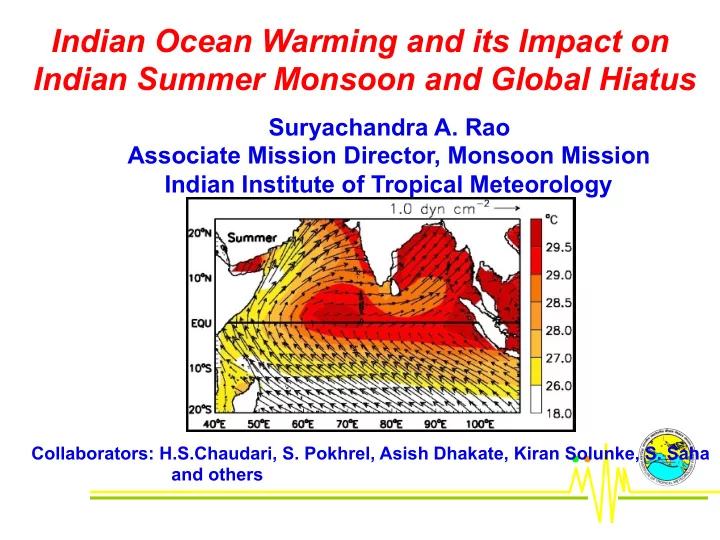

Indian Ocean Warming and its Impact on Indian Summer Monsoon and Global Hiatus Suryachandra A. Rao Associate Mission Director, Monsoon Mission Indian Institute of Tropical Meteorology Collaborators: H.S.Chaudari, S. Pokhrel, Asish Dhakate, Kiran Solunke, S. Saha and others
Outline 1. Why Indian Ocean is Warming Consistently? 2. What is its impact on Indian Summer Monsoon a. Seasonal Mean b. Intraseasonal Oscillations c. Extreme Rainfall Events d. Global warming Hiatus
Data and Model • TMI & Reynolds SST • Merged Sea Surface Height data • NCEP/NCAR and SODA/GODAS/ECCO reanalysis • ECHAM-5 AGCM (T106L19) • Data from CMIP5 Models
70% of the World Ocean Heat gain is in IO Indian Ocean Warm Pool
Relative Role of surface heat fluxes and Ocean Dynamics for warming/expansion of warm pool Role of net surface heat fluxes Role of latent heat fluxes on SST trend on SST trend Net heat Fluxes (dominated by latent heat flux) try to cool the Ocean, particularly in the central tropical IO
Reynolds area anomalies Vs. Merged SSH anomalies TMI area anomalies Vs. Merged SSH anomalies
Relation between area anomalies and other parameters Q net SSHA Winds OLRA
Rao et al., (2012). Climatic Change
Roxy et al., (2014) CMIP5 Models get much less warming than Observed in the Rest of the Indian Ocean. WIO warming is Overestimated. 11 th March 2010. INCOIS, HYderabad
Indian Ocean Warming, Walker Circulation & El Nino: Skewness El Nino warms Western IO significantly, however Lan Nina do not cool the WIO with Same magnitude.
2008 Indian Monsoon Rainfall anomalies and deviations from normal IOD
SST ANOMALIES Indian Ocean Dipole and Its influence on Indian Summer Monsoon
SST Differences in 2008
Indian Ocean warming trend and Monsoon Rainfall
Model response to different SSTA forcings IOD run IOD +SIO Warming run SIO response
Modulation of Local Hadley Circulation (Vertical Velocities averaged between 70 o E-90 o E) Observations Model Rao et al., (2010). Journal of Climate
Indian Ocean Warming weakens Monsoon Roxy et al., (2014)
CMIP5 Models Projections
Observations Model Expt.
ISO Variance Trend (1970-2012) ISO variance is increasing over Indian land mass and eastern Indian Ocean
Space-Time Spectra of Rainfall (10 o S- 30 o N, 65 o E-95 o E) ISO variance is increasing & Propagation speed is slightly decreasing
Space-Time Spectra of Rainfall (10 o S- 30 o N, 65 o E-95 o E) in Model Expts. ISO variance is increasing & Propagation speed is slightly decreasing
Mechanism to modulate ISO variance
CMIP5 Model Projections of ISO JJAS Mean Rainfall Bias in CMIP5 models. Dry Bias over India and Eastern Indian Ocean is a common feature
CMIP5 Model Projections of ISO Variance JJAS ISO Variance bias in CMIP5 models. Dry Bias over India and Eastern Indian Ocean is a common feature
CMIP5 Model Projections of MISO Propagation JJAS MISO Variance bias in CMIP5 models. Dry Bias over India and Eastern Indian Ocean is a common feature
Number of Heavy Rainfall Events
Correlation between number of heavy rainfall events and SST(SSH) anomalies
Correlation between Extreme Rainfall events with SLP, Moisture Divergence and vorticity Ajayamohan and Rao , (2008). JMSJ
Global Warming Hiatus Trend in SST/Air. Temp SST Trend during hiatus
Global Warming Hiatus Indian Ocean vs Pacific Relation weakening? AGCM expt. 11-year running correlation between Nino 3.4 and IO SST
Other Aspects of Indian Ocean Warming and recent trends
Indian Ocean Warming and Primary productivity Primary productivity is decreasing rapidly in recent periods. Roxy et al., (2016)
Jin & Wang, 2017 Monsoon Rainfall Decreasing trend is Revived after 2002
I950-2002 Trends 2002-2012 Trends
Conclusions • Indian Ocean is warming consistently for last 50 years • Coupled Positive feedback is responsible for the above observation • Monsoon rainfall over central India may reduce considerably in the above scenario • Monsoon Intraseasonal Oscillations are modulated considerably under warming. • Number of extreme rainfall events may increase due to Indian Ocean warming • Global warming Hiatus is partially due to IO warming
Recommend
More recommend